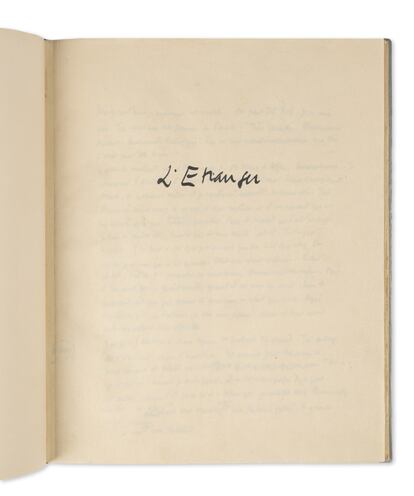Only two manuscripts of Abroad. The first is kept in a library in the south of France. The second belonged to an anonymous collector and was auctioned this Wednesday in Paris for 500,000 euros. Its 104 pages contain annotations in the margins, crossing outs and sketches. But its value also lies in the mystery that surrounds it. Despite being dated 1940, its author, the Frenchman Albert Camus, wrote it in 1944, two years after the publication of his iconic novel, according to testimonies from his family. A detail that allows us to get closer to the context of the time and outline certain traits of the personality of the Nobel Prize winner in Literature.
The manuscript, written in the aftermath, barely appeared twice in public sales. In 1958 and in 1991. But the auction at the Tajan house this Wednesday has put it back in the spotlight, although gray areas remain in its history. Why did Camus decide to rewrite an already published novel by hand? Was it a farce? A commission? Or perhaps a way to make extra money, taking advantage of the nascent success of Abroad? There are no certainties, but there are some clues.
Scholars of the author often refer to the testimony of Francine Faure, his wife, who in 1970 told specialist André Abbou that the rewriting was probably done “to satisfy the young writer’s need for money.” In 1944, Camus was 31 years old, living in Paris and working for the underground magazine Combat, spokesperson for the French Resistance against the German invasion in World War II. His income, however, was obtained mainly from Gallimard, the famous publishing house for which he worked as a reader and which gave him an advance on his copyright, says Anne Prouteau, president of the Society for Camus Studies, in a telephone conversation. .
Although it is unknown to whom the manuscript was sold, the experts of the Nobel Prize in Literature in 1957 highlight the growing interest that bibliophiles had in this type of texts. “A publishing historian whom I interviewed told me that during the occupation (of France) there was an art and autograph market in full expansion,” Mohammed Aïssaoui, author of the book, explains to this newspaper. Love Dictionary by Albert Camus and journalist Le Figaro.
The Tajan auction house, in a note, points out that the then young essayist realized the commercial value of his manuscript and the benefits he could obtain. Abroad, published in 1942, did not yet have the success that it would experience after the war, but it already enjoyed a certain renown in the Parisian intellectual circle of the time. A year after its publication, the philosopher and writer Jean-Paul Sartre published a review of the text, which gave it greater interest.
The testimony of Francine Faure, Camus’s wife, adds another detail: it was Josette Clotis, a friend, who dictated her own text to the Nobel Prize winner. The woman, barely three years older than him, was the partner of the novelist André Malraux, who was then working for Gallimard. A presence that Catherine Camus, the daughter of the Nobel Prize winner, also confirmed in an interview in 2014 with Alice Kaplan, professor at the American University of Yale and author of the essay In search of the Stranger (In search of ‘The Stranger’).
Was it Malraux who recommended the young author write the manuscript? The question remains unanswered. But what is interesting, according to Prouteau, is to remember the role of the novelist in the edition of Abroad. “When he received the working manuscript of the work, in 1941, he immediately saw that it was a great text, he made some recommendations to Camus (…) and then he really supported the edition of the text in Gallimard,” he remarks.
Suns, cartoons and guillotines
Regardless of whether or not it was written with the aim of earning extra income, the manuscript itself is “a very beautiful object,” highlights Ségolène Beauchamp, an expert on ancient and modern books. The piece was valued between 500,000 and 800,000 euros. Its rigid cover is decorated with golden geometric lines. “The sheets are abundantly filled, used, the margins are still wide, but on them she wrote many comments, corrections, and added a dozen small drawings, which is quite exceptional in her work,” she describes.
The drawings are accompanied by fragments of text. There are caricatures of characters, suns and guillotines, these in three sizes. “The closer we get to the end of the novel, the more important the guillotine becomes. The last one, for example, takes up two-thirds of the page,” Beauchamp points out. The comments, he adds, contain elements of humor and some refer to two other works he was working on: The myth of Sisyphuspublished in 1942, and Caligulafrom 1944.
However, by noting that the date of the manuscript was 1940, Camus suggests that it was the true draft of his famous novel. “I insist on the playful, mischievous, slightly farcical dimension” that the manuscript contains, says Prouteau. “I don’t think Camus would be displeased (…) not to make fun of it, but to be a little ironic about the economic attractiveness of such manuscripts for bibliophiles.” Meanwhile, Aïssaoui adds: “Camus has been analyzed in a thousand ways. Personally, I perceived this slightly joking side thanks to Catherine Camus, whom I met for my Love Dictionary by Albert Camus. He told me about his father, a man who sang popular songs at the top of his lungs.”
Abroad It centers on a young French Algerian employee, named Meursault, who narrates how he kills an Arab for unclear reasons. Initially 4,400 copies were printed, over time it became a bestseller and a classic of French literature.
Subscribe to continue reading
Read without limits
_

